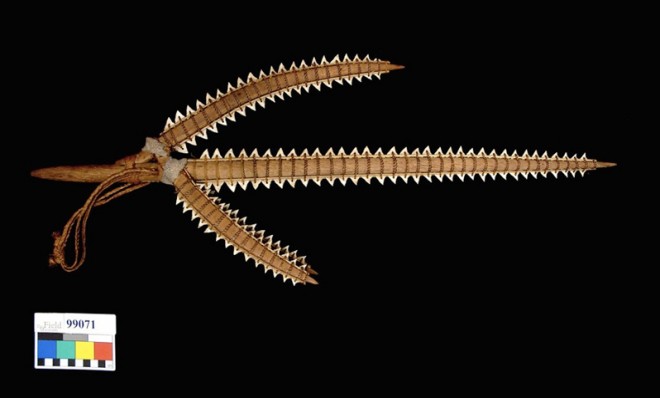How ancient shark-tooth swords uncovered two long-lost species
Biologists spot some peculiar shark teeth among a collection of "badass" weaponry

Biologist Joshua Drew's surprise discovery began as many do: "I just wanted to... look at really cool stuff," he tells The Los Angeles Times. Drew, now a postdoctoral researcher at Columbia University, was with a few colleagues at the Field Museum of Natural History in Chicago scoping out a new exhibit — a collection of "badass" swords, knives, and lances once used by the inhabitants of the Central Pacific's Gilbert Islands 130 years ago to rip their enemies to shreds.
This particular arsenal wasn't pounded out of iron or steel, though. The 124 flesh-tearing weapons on display had a more biological origin, and were carved out of wood, with each blade edge carefully outfitted with rows of dagger-like shark teeth.
Drew was admiring the pieces when he noticed something strange: A few of the teeth appeared to belong to dusky and spottail sharks, which, oddly, aren't typically found near the Gilbert Isles. How could he tell, you might ask? Well, he was in a natural history museum, and could easily look up fossil records to confirm his suspicions.
The Week
Escape your echo chamber. Get the facts behind the news, plus analysis from multiple perspectives.

Sign up for The Week's Free Newsletters
From our morning news briefing to a weekly Good News Newsletter, get the best of The Week delivered directly to your inbox.
From our morning news briefing to a weekly Good News Newsletter, get the best of The Week delivered directly to your inbox.
"Shape, serration patterns, and other features of shark teeth were enough for researchers to identify the species," says LiveScience.
Using field guides and the museum's collections of shark jaws, the researchers identified teeth from eight species of shark on 122 weapons and teeth collections from the Gilbert Islands. The most common of those species was the silvertip shark (C. albimarginatus), whose teeth graced 34 weapons. Gilbert Islands weapon-makers also used teeth from silky sharks, oceanic whitetip sharks, tiger sharks, blue sharks, and hammerheads. [Live Science]
Yet, a deep-dive through history revealed no evidence that the dusky and spottail sharks had ever lived in Gilbert Island's reefs. While trading with other far-away cultures could explain how the teeth got there, the likelier answer is one we've already heard before:
"Probably, they were fished out," says Drew. Although it's not clear why the sharks disappeared, says Ed Yong at National Geographic — "people were hacking off shark fins in the Gilbert Islands as far back as 1910 and by the 1950s, around 3,000 kilograms of fins were being shipped from the islands every year." It's become so bad that some conservationists estimate that 100 million sharks are killed worldwide every year.
After publishing their findings this month in the journal PLoS One, Drew and his team hope that the discovery of a "shadow biodiversity" along the Gilbert Island's waters will aid conservation efforts for marine animals that have been over-fished for decades:
A free daily email with the biggest news stories of the day – and the best features from TheWeek.com
Given the importance of these species to the ecology of the Gilbert Island reefs and to the culture of the Gilbertese people, documenting these shifts in baseline fauna represents an important step toward restoring the vivid splendor of both ecological and cultural diversity. [PLoS One]
That's something worth sinking your teeth into.
-
 How the War Department became the Department of Defense – and back again
How the War Department became the Department of Defense – and back againIn Depth In 1947 President Harry Truman restructured the US military establishment, breaking with naming tradition
-
 Codeword: December 8, 2025
Codeword: December 8, 2025The daily codeword puzzle from The Week
-
 Sudoku medium: December 8, 2025
Sudoku medium: December 8, 2025The daily medium sudoku puzzle from The Week